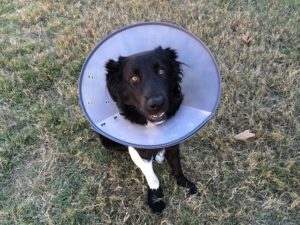
In this blog, we will discuss some tips, tricks, and benefits of using an E-collar after veterinary surgery.
Fostering recovery for your fur-baby after veterinary surgery can be incredibly difficult. Our companions do not always know what is best for their health and may paw, lick, or scratch at incision sites or stitches. When guardians look to keep their companions from tearing open stitches or otherwise hindering recovery, they often opt for an E-collar. This week, we will discuss some tips, tricks, and benefits of using an E-collar after veterinary surgery.
What is an E-Collar?
“E-collar” is actually short for “Elizabethan collar,” though many people simply refer to the device as a cone. Named after accessories worn during the Elizabethan era, these cones can be made of plastic, fabric, foam, or a combination of different materials. E-collars can be used for both feline and canine companions, and a plethora of sizes, colors, closures, and styles are available. After veterinary surgery, E-collars are used to keep the patient from opening stitches, licking their incision site, or otherwise causing setbacks in their recovery.
When Should Guardians Consider an E-Collar?
In short, guardians should use an E-collar when their veterinary care team prescribes it. After veterinary surgery, your companion’s surgeon may prescribe the use of an E-collar along with antibiotics, pain medication, and routine bandage care. For things like ophthalmic procedures, E-collars can be particularly vital in preventing further injury to delicate organs during recovery. Although your fur-baby may not like their cone, you should continue using it as directed by your veterinary care team to ensure healthy healing.
Tips for Using an E-Collar After Veterinary Surgery
Many companions dislike the experience of wearing a cone after veterinary surgery. Patients may find them uncomfortable, and they can encounter difficulty moving, eating, or using a litter box. Fortunately, there are a few things that guardians can do to make recovery with an E-collar a bit easier. Raising your companion’s food and water dishes can make them more accessible, and removing the lid from covered litter boxes may make it easier to enter. You may want to restrict your fur-baby to a dedicated “recovery suite” in your home that they can easily navigate without bumping into furniture and objects. Finally, make sure to keep your companion’s collar clean and dry. This will prevent the formation of abrasions, infections, and hot spots.
Trust Maryland Veterinary Surgical Services With Your Companion’s Health
Your companion’s health is important, and the team at MVSS is ready to provide the best care possible for your furry family. We are dedicated to combining comprehensive exams and assessments with informative and honest discussions of your companion’s care. Once we have worked with you to decide on the best course of action for your dog, our professionals will use their surgical expertise to work towards the goal of giving your companion an active and pain-free life. We are proud to serve loyal companions in Catonsville and Baltimore. To learn more about our services, give us a call at 410-788-4088 or visit us online. For more information and tips for pet health, follow us on Facebook and Pinterest.
